-
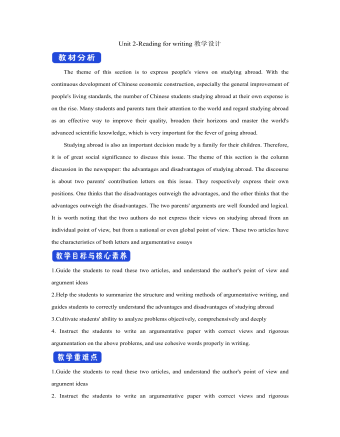
新人教版高中英语选修2Unit 2 Reading for writing教学设计
The theme of this section is to express people's views on studying abroad. With the continuous development of Chinese economic construction, especially the general improvement of people's living standards, the number of Chinese students studying abroad at their own expense is on the rise. Many students and parents turn their attention to the world and regard studying abroad as an effective way to improve their quality, broaden their horizons and master the world's advanced scientific knowledge, which is very important for the fever of going abroad. Studying abroad is also an important decision made by a family for their children. Therefore, it is of great social significance to discuss this issue. The theme of this section is the column discussion in the newspaper: the advantages and disadvantages of studying abroad. The discourse is about two parents' contribution letters on this issue. They respectively express their own positions. One thinks that the disadvantages outweigh the advantages, and the other thinks that the advantages outweigh the disadvantages. The two parents' arguments are well founded and logical. It is worth noting that the two authors do not express their views on studying abroad from an individual point of view, but from a national or even global point of view. These two articles have the characteristics of both letters and argumentative essays1.Guide the students to read these two articles, and understand the author's point of view and argument ideas2.Help the students to summarize the structure and writing methods of argumentative writing, and guides students to correctly understand the advantages and disadvantages of studying abroad3.Cultivate students' ability to analyze problems objectively, comprehensively and deeply
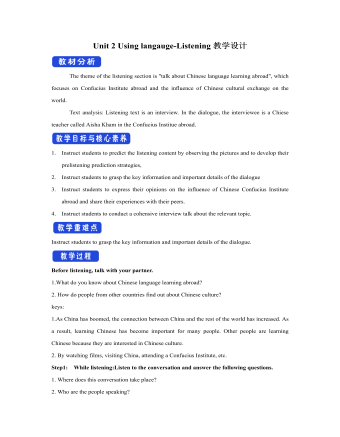
新人教版高中英语选修2Unit 2 Using langauge-Listening教学设计
? B: Absolutely! Getting involved with Chinese cultural activities there definitely helped a lot. I got to practice my Chinese on a daily basis, and I could learn how native Chinese speakers spoke.? A: What do you feel is your biggest achievement?? B: Learning Chinese characters! I have learnt about 1,500 so far. When I first started, I didn't think it was even going to be possible to learn so many, but now I find that I can read signs, menus, and even some easy newspaper articles.? A: What are you most keen on?? B: I've really become keen on learning more about the Chinese culture, in particular Chinese calligraphy. As I have learnt Chinese characters, I have developed a great appreciation for their meaning. I want to explore Chinese characters by learning how to write them in a more beautiful way. ? A: Finally, what do you want to say to anyone interested in learning Chinese?? I have really become keen on learning more about the Chinese culture, in particular Chinese Calligraphy. As I have learnt Chinese character, I have developed a great appreciation for their meaning. I want to explore Chinese characters by learning how to write them in a more beautiful way.? A: Finally, what do you want to say to anyone interested in learning Chinese?? B: I'd say, give it a shot! While some aspects may be difficult, it is quite rewarding and you will be happy that you tried.? A: Thanks for your time. ? B:You're welcome.
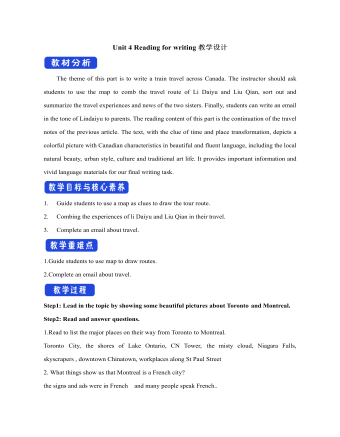
新人教版高中英语选修2Unit 4 Reading for writing教学设计
假定你是英国的Jack,打算来中国旅行,请你给你的中国笔友李华写一封信,要点如下:1.你的旅行计划:北京→泰山→杭州;2.征求建议并询问他是否愿意充当你的导游。注意:1.词数80左右(开头和结尾已给出,不计入总词数);2.可以适当增加细节,以使行文连贯。参考词汇:故宫 the Forbidden City;泰山 Mount TaiDear Li Hua,I'm glad to tell you that 'm going to visit China.First,I am planning to visit Beijing,the capitalof China,where I am looking forward to enjoying the Great Wall,the Forbidden City and somebeautiful parks.Then I intend to go to visit Mount Tai in Shandong Province.I've heard that it is one ofthe most famous mountains in China and I can't wait to enjoy the amazing sunrise there.After that,I amalso going to Hangzhou.It is said that it is a beautiful modern city with breathtaking natural sights,among which the West Lake is a well- known tourist attraction.What do you think of my travel plan? Will you act as my guide? Hope to hear from you soon.

新人教版高中英语选修2Unit 4 Using langauge-Listening教学设计
The theme of the listening section is " talking about scenery and culture along a journey."The part is designed to further lead the students to understand Canadian natural geography and social environment, and integrated into the cultural contrast by mentioning the long train journey from Beijing to Moscow routes. On this basis, the part activates students related travel experience, lets the student serial dialogue, guides the student to explore further the pleasure and meaning of the long journey, and Chinese and foreign cultural comparison.The part also provides a framework for the continuation of the dialogue, which is designed to provide a framework for students to successfully complete their oral expressions, and to incorporate an important trading strategy to end the dialogue naturally.1. Help students to understand and master some common English idioms in the context, and experience the expression effect of English idioms.2. Guide the students to understand the identity of different people in the listening context, and finish the dialogue according to their own experience.3. Instruct the students to use appropriate language to express surprise and curiosity about space and place in the dialogue, and master the oral strategy of ending the dialogue naturally.1. Instruct students to grasp the key information and important details of the dialogue.2. Instruct students to conduct a similar talk on the relevant topic.

新人教版高中英语选修2Unit 5 Learning about Language教学设计
The purpose of this section of vocabulary exercises is to consolidate the key words in the first part of the reading text, let the students write the words according to the English definition, and focus on the detection of the meaning and spelling of the new words. The teaching design includes use English definition to explain words, which is conducive to improving students' interest in vocabulary learning, cultivating their sense of English language and thinking in English, and making students willing to use this method to better grasp the meaning of words, expand their vocabulary, and improve their ability of vocabulary application. Besides, the design offers more context including sentences and short passage for students to practice words flexibly.1. Guide students to understand and consolidate the meaning and usage of the vocabulary in the context, 2. Guide the students to use the unit topic vocabulary in a richer context3. Let the students sort out and accumulate the accumulated vocabulary, establishes the semantic connection between the vocabulary,4. Enable students to understand and master the vocabulary more effectivelyGuiding the Ss to use unit topic words and the sentence patterns in a richer context.Step1: Read the passage about chemical burns and fill in the blanks with the correct forms of the words in the box.
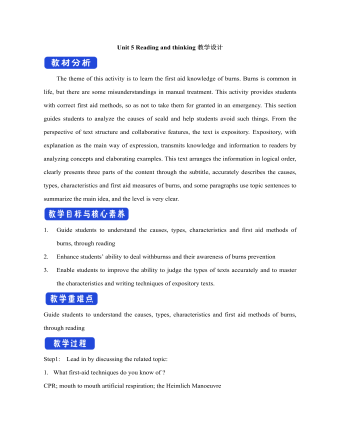
新人教版高中英语选修2Unit 5 Reading and thinking教学设计
The theme of this activity is to learn the first aid knowledge of burns. Burns is common in life, but there are some misunderstandings in manual treatment. This activity provides students with correct first aid methods, so as not to take them for granted in an emergency. This section guides students to analyze the causes of scald and help students avoid such things. From the perspective of text structure and collaborative features, the text is expository. Expository, with explanation as the main way of expression, transmits knowledge and information to readers by analyzing concepts and elaborating examples. This text arranges the information in logical order, clearly presents three parts of the content through the subtitle, accurately describes the causes, types, characteristics and first aid measures of burns, and some paragraphs use topic sentences to summarize the main idea, and the level is very clear.1. Guide students to understand the causes, types, characteristics and first aid methods of burns, through reading2. Enhance students’ ability to deal withburnss and their awareness of burns prevention3. Enable students to improve the ability to judge the types of texts accurately and to master the characteristics and writing techniques of expository texts.Guide students to understand the causes, types, characteristics and first aid methods of burns, through readingStep1: Lead in by discussing the related topic:1. What first-aid techniques do you know of ?CPR; mouth to mouth artificial respiration; the Heimlich Manoeuvre
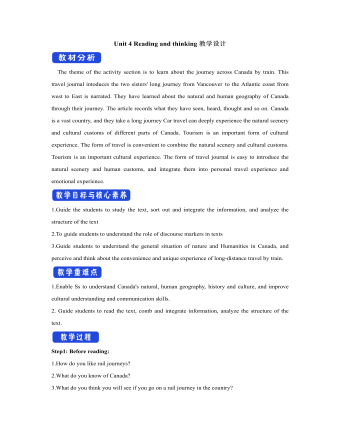
新人教版高中英语选修2Unit 4 Reading and thinking教学设计
【词汇精讲】highlight n.最好或最精彩的部分 vt.突出;强调;使醒目One of the highlights of the trip was seeing the Taj Mahal.这次旅行的亮点之一是参观泰姬陵。Your resume should highlight your skills and achievements.你的简历应该突出你的技能和成就。The report highlights the major problems facing society today.报告强调了当今社会所面临的主要问题。I’ve highlighted the important passages in yellow.我用黄色标出了重要段落。7.Edmonton is freezing cold in winter,with daily temperatures averaging -10 ℃.埃德蒙顿冬季寒冷,日平均气温为-10°C。【词汇精讲】freezing adj.极冷的;冰冻的Leave a basin of water outside in freezing weather.在冰冻的天气里,放一盆水在室外。It’s freezing cold outside so wear a warm coat.外面超冷的,所以穿一个暖和一点的外套吧。8.It was not until 9:30 a.m.that they finally reached the capital of Ontario,Toronto.直到上午9时30分,他们才终于到达多伦多的首府安大略省。【句式剖析】本句是一个强调句,强调的是句子的时间状语until 9:30。含有not...until...的句子的强调句为It is not until...that...,that后面的句子要用肯定形式。It was not until then that I suddenly realized nobody was happier than I was.直到那时我才突然意识到没有人比我更幸福了。
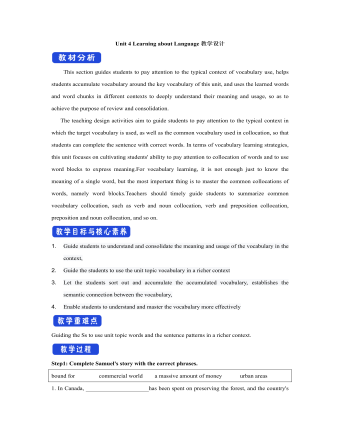
新人教版高中英语选修2Unit 4 Learning about Language教学设计
This section guides students to pay attention to the typical context of vocabulary use, helps students accumulate vocabulary around the key vocabulary of this unit, and uses the learned words and word chunks in different contexts to deeply understand their meaning and usage, so as to achieve the purpose of review and consolidation.The teaching design activities aim to guide students to pay attention to the typical context in which the target vocabulary is used, as well as the common vocabulary used in collocation, so that students can complete the sentence with correct words. In terms of vocabulary learning strategies, this unit focuses on cultivating students' ability to pay attention to collocation of words and to use word blocks to express meaning.For vocabulary learning, it is not enough just to know the meaning of a single word, but the most important thing is to master the common collocations of words, namely word blocks.Teachers should timely guide students to summarize common vocabulary collocation, such as verb and noun collocation, verb and preposition collocation, preposition and noun collocation, and so on.1. Guide students to understand and consolidate the meaning and usage of the vocabulary in the context, 2. Guide the students to use the unit topic vocabulary in a richer context3. Let the students sort out and accumulate the accumulated vocabulary, establishes the semantic connection between the vocabulary,4. Enable students to understand and master the vocabulary more effectivelyGuiding the Ss to use unit topic words and the sentence patterns in a richer context.

新人教版高中英语选修2Unit 5 Using langauge-Listening教学设计
The theme of this section is to learn how to make emergency calls. Students should learn how to make emergency calls not only in China, but also in foreign countries in English, so that they can be prepared for future situations outside the home.The emergency telephone number is a vital hotline, which should be the most clear, rapid and effective communication with the acute operator.This section helps students to understand the emergency calls in some countries and the precautions for making emergency calls. Through the study of this section, students can accumulate common expressions and sentence patterns in this context. 1.Help students accumulate emergency telephone numbers in different countries and learn more about first aid2.Guide the students to understand the contents and instructions of the telephone, grasp the characteristics of the emergency telephone and the requirements of the emergency telephone.3.Guide students to understand the first aid instructions of the operators.4.Enable Ss to make simulated emergency calls with their partners in the language they have learned1. Instruct students to grasp the key information and important details of the dialogue.2. Instruct students to conduct a similar talk on the relevant topic.Step1:Look and discuss:Match the pictures below to the medical emergencies, and then discuss the questions in groups.
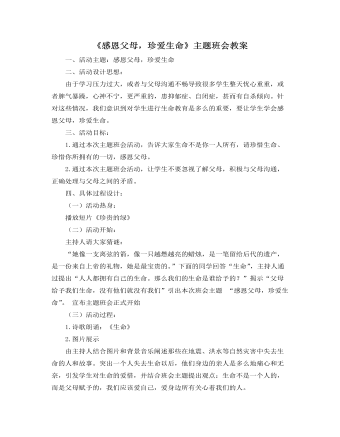
《感恩父母,珍爱生命》主题班会教案
6.回想幸福闭目放松,仔细回想:(1)父母养育、关爱自己的一些难忘的事。(2)父母工作、做家务的辛苦与劳累。(3)和父母在一起的难忘的快乐时光。(同学们展示准备好的与爸爸或妈妈在一起的照片。)从内心深处表达对他们的感激:(1)感谢他们的养育之恩。(2)表达努力学习的决心,尽力让他们放心。(3)决定做一件令他们开心满意的事情。7.手语表演:“感恩的心”(全班起立齐唱。)在背景音乐“感恩的心”中,同学们在“感恩父母、珍爱生命”的横幅上郑重签名,以表自己的决心。(四)活动小结:1. 主持人作小结,倡导同学们为了自己,为了身边爱自己的人珍惜生命,主动去了解父母,积极与父母沟通,正确处理与父母之间的矛盾。2. 主持人宣布活动圆满结束。
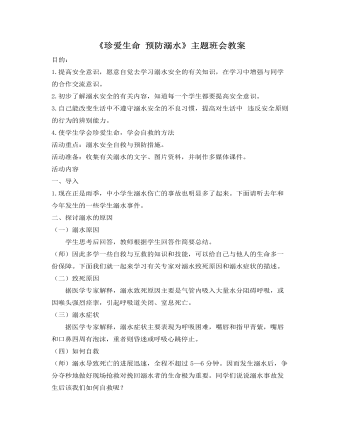
《珍爱生命 预防溺水》 主题班会教案
(2)如何开展岸上急救 第一步:当溺水者被救上岸后,应立即将其口腔打开,清除口腔中的分泌物及其他异物。如果溺水者牙关紧闭,要从其后面用两手的拇指由后向前顶住他的下颌关节,并用力向前推进。同时,两手的食指与中指向下扳颌骨,即可搬开他的牙关。 第二步:控水。救护者一腿跪地,另一腿屈膝,将溺水者的腹部放到屈膝的大腿上,一手扶住他的头部,使他的嘴向下,另一手压他的背部,这样即可将其腹内水排出。 第三步:如果溺水者昏迷,呼吸微弱或停止,要立即进行人工呼吸,通常采用口对口吹气的方法效果较好。若心跳停止还应立即配合胸部按压,进行心脏复苏。心肺复苏的目的在于尽快挽救脑细胞,避免因缺氧引起细胞坏死。因此施救越快越好,同时注意要在急救的同时,要迅速打急救电话,或拦车送医院。
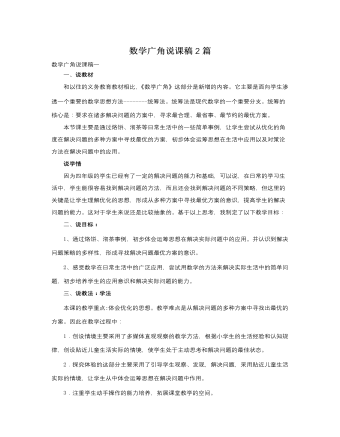
人教版新课标小学数学三年级上册数学广角说课稿2篇
三、说教学理念:通过观察、猜测及动手操作实验等方法,向学生渗透有序的数学思想。四、说教学过程:一、创设情境、激趣导入。小朋友们喜欢什么样的球类运动呢?让学生各抒已见。当有人说到足球时。老师马上引到学校冬季运动会,我们三年级3个班的比赛情况,结果我们班得了第一。那我们班比赛了几场?学生回答两场。三个班比赛,每两个班比赛一场,那一共要比赛多少场呢?四人小组合作完成。然后汇报,并说理由。二.动手实践,自主探究1.2002年世界杯足球C组比赛有几国家?是哪几个国家?让学生发表意见。他们说不出,老师再告诉他们。2.如果这四个队每两个队踢一场球,一共要踢多少场?(课件演示主题图)3.让学生大胆说一说、猜一猜。4.四人小组用学具卡片摆一摆、讨论讨论。
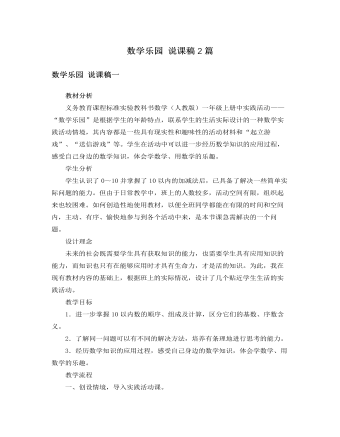
人教版新课标小学数学一年级上册数学乐园 说课稿2篇
这是一个所有学生都非常熟悉的学习生活事例,这个事例中包含着基数和序数知识。通过这个活动,可以使学生实实在在地体会到生活中的数学,切实感受数学与自己学习生活的密切联系,使他们学会用数学的眼光去观察身边的事物。5、锤子、剪刀、布这是一个学生都非常感兴趣的游戏,游戏蕴涵了统计和比多少的知识。这样既巩固了比多比少的知识,又使学生体会了比多少的知识在实际生活中的应用,同时还让学生学习了简单的数据整理的方法。教学目标:1、进一步掌握10以内的数的大小顺序,加深对基数和序数的认识,以及10以内数的加减法,提高口算能力。2、灵活运用知识解决问题的能力和与他人团结合作的能力3、培养学生团结合作的意识,体验学数学、用数学的乐趣。
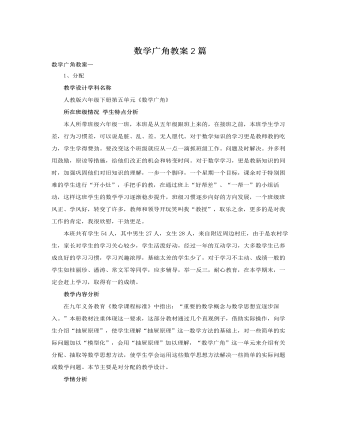
人教版新课标小学数学六年级下册数学广角教案2篇
一、创设情境,猜想验证1.猜一猜,摸一摸。一盒粉笔若干支,5种不同的颜色。至少摸几支能保证:(1)2支同色的。(2)3支同色的。(3)4支同色的。2.想一想,摸一摸。请学生独立思考后,先在小组内交流自己的想法,再动手操作试一试,验证各自的猜想。在这个过程中,教师要加强巡视,要注意引导学生思考本题与前面所讲的抽屉原理有没有联系,如果有联系,有什么样的联系,应该把什么看成抽屉,要分放的东西是什么。二、观察比较,分析推理1.说一说,在比较中初步感知。2.想一想,在反思中学习推理。三、深入探究,沟通联系四、对比练习,感悟新知1.说一说。把红、黄、蓝、白四种颜色的球各10个放到一个袋子里。至少取多少个球,可以保证取到两个颜色相同的球?2.算一算。向东小学六年级共有370名学生,其中六(2)班有49名学生。请问下面两人说的对吗?为什么?五、总结评价六、布置作业
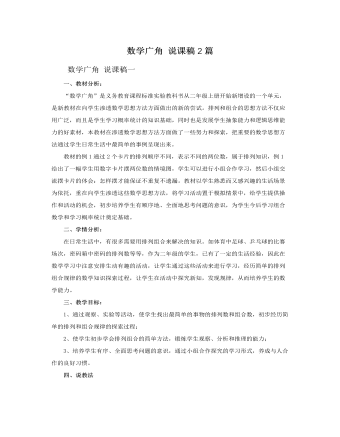
人教版新课标小学数学二年级上册数学广角 说课稿2篇
对比分析为什么刚才咱们从不同的3个数字中选出两个,可以摆成6个不同的两位数,而现在三个同学每两个握一次手,就一共只握了3次呢?(学生讨论,发表意见)(握手不存在调换位置的情况,跟顺序无关,而排列数,位置调换就变成另一个数,与顺序有关。)三、实践应用,巩固新知师引导:同学们今天说得太精彩了!那我们就进数学广角痛痛快快地玩玩吧!(出示课件)问:进去吗?(再次打开课件,欣赏)1、快乐狗活动室(练习二十三第2题)质疑:咦,机灵猫,兰兰他们去哪了?呵,机灵猫猫想要运动运动,就来到了快乐狗活动室。(课件展示)机灵猫就是机灵猫,看他们打球还想到问题了:如果每两个人打一场乒乓球比赛,他们三人一共要打多少场比赛呢?谁能很快说出来!(学生分析,指名说说)2、小喜鹊超市(练习二十三第1题)
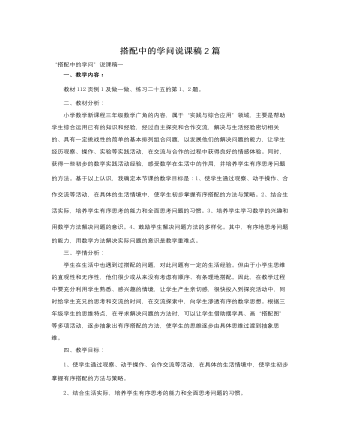
人教版新课标小学数学三年级上册搭配中的学问说课稿2篇
师:同学们真聪明,小精灵的问题回答出来了,现在就让我们一起走进儿童乐园吧。(出示课件)请大家注意观察,儿童乐园中都有哪些景点?师:从儿童乐园出发经过百鸟园去猴山一共有几条路?请同学们仔细观察:从儿童乐园到百鸟园有几条路?从百鸟园去猴山有几条路?(生回答。)师:我们给这5条路分别标上序号。(课件演示)现在请同学们想一想从儿童乐园的入口经过百鸟园到达猴山一共有几条路线?请同学们把答案写在记录纸上。(生汇报。)师:路线设计好了,让我们一起到猴山看一看可爱的小猴子吧!(放猴山的录像。)师:看,它们是一对著名的动物小明星,会演杂技的小猴宝宝和贝贝,你们想和它们照相留念吗?生:想。师:好!那我们每个人都和宝宝、贝贝各照一张相片,同学们想一想,我们全班40个人一共要照多少张相片儿呢?
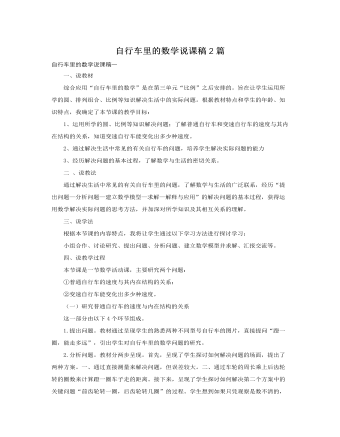
人教版新课标小学数学六年级下册自行车里的数学说课稿2篇
(三)实践活动(运用)接着,我设计了实践活动,让学生走出教室,在校园找到不同型号的自行车有四辆我把学生分成四组,并且分工合作,每组5个人,有3 个人负责采集数据,有两个人负责计算出结果。教师还要在旁边指导测量的方法,让学生学会收集数据。培养学生学会用数学的眼光观察现实生活,从中发现问题,提出问题,解决问题,体会数学的广泛应用与实际价值,获得良好的情感体验。数学模型方法的教学,还要培养学生运用模型解决现实问题的能力。因此,在学生理解模型之后,老师提供各种各样的现实问题,引导学生运用所得的数学模型去解决。在这个过程中,教师的指导非常重要,教师要指导学生把现实问题的元素与数学模型中的元素建立丐联系,还要指导学生如何运用已经建构的数学模型来分析和处理问题。学生经历了这样的学习过程,他们才会感受到数学模型的力量,才会感受到数学学习的乐趣。
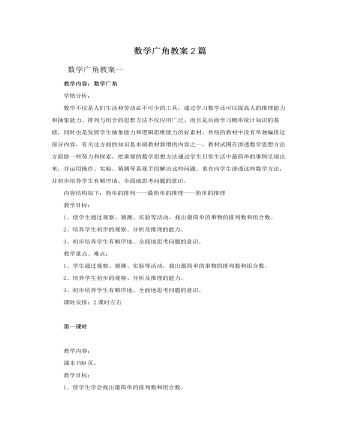
人教版新课标小学数学二年级上册数学广角教案2篇
方法三:我先把数字1放在个位,然后把数字2和3分别放在十位组成21和31;我再把数字2放在个位,然后把数字1和3分别放在十位组成12和32;我再把数字3放在个位,然后把数字1和2分别放在十位组成13和23,一共摆出了6个两位数。(21、31、12、32、13、23)每种方法说完后师问:还能摆吗?(再摆就要重复了!提示:不能遗漏也不能重复)师小结:排数的时候按照一定的顺序既不会重复也不会遗漏。我们用3个不同的一位数拼成了几个不同的两位数?(板书:6个)可拓展:三只动物抽到卡片后最多能组成21、31、32那谁可以和聪聪一起坐呀?小猫很幸运,他抽到了2和3,那么他一定会摆出一个……(三)握手小动物们谢谢我们帮他们一起解决了这些数学问题,一定要让老师表示谢意,好谢谢你们。(老师过去和学生握手。分别找几个人握手,让学生观察,每两个人握一次手。)
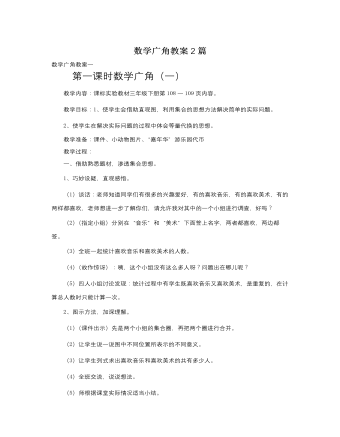
人教版新课标小学数学三年级下册数学广角教案2篇
1、同学们都听说过“曹冲称象”的故事吧!曹冲是怎么称出大象的重量的呢?让我们一起来回顾这一过程。2、曹冲是把大象的重量转换成了什么的重量呢?【他是把大象的重量转换成了与它重量相等的石头的重量】因为当时没有那么大的称能直接称出大象的重量,所以曹冲就用石头的重量代换了大象的重量,称出了石头的重量也就知道了大象的重量。3、同学们,你们大概还不知道吧,曹冲确实非常了不起,他运用了一种重要的数学思考方法——等量代换。【板书:数学广角——等量代换】这节课我们就来学习如何用“等量代换”的方法解决问题。二、引导探究发现规律1、今天这节课,老师给同学们带来了神秘的礼物。猜猜,什么样的孩子能够得到它们?全班?个大组,哪组的成员在参与过程中积极主动,认真动脑思考,遵章守纪,老师就奖励这个组一个青苹果,三个青苹果可以换一个红苹果,两个红苹果可以换取一份神秘的礼物。看看哪个组能得到礼物。有信心吗?老师相信你们是最棒的。

人教版新课标小学数学四年级下册数学广角教案2篇
一、初步感知间隔的含义1、请同学们伸出右手,张开,数一数,5个手指之间有几个空格?在数学上,我们把 空格叫做间隔,也就是说,5个手指之间有几个间隔?4个间隔是在几个手指之间?2. 其实,这样的数学问题,在我们的生活中,随处可见。谁能举几个这样的例子3、看图:在画面上我们看到春天桃红柳绿,到处是一派生机勃勃的景象,你们知道吗?3月12日是什么日子,这一天全国上下到处都在植树,为保护环境献出自己的一份力量。 出示图:这里从头到尾栽了几棵树,数一数,它们之间又有几个间隔呢?你发现了什么?谁来说一说?同时板书。4、那你能像这样用一个图表示出来吗?请你们选择一种动手画一画吧!5、汇报:画了8棵树,他们之间有7个间隔数,9棵树之间有8个间隔。……6、你发现植树棵树和间隔数之间有什么规律呢?(自己先想想,再把你的想法和伙伴们互相交流一下)。反馈:谁来说说你的发现?评价:哦,这是你的发现……你还能用一个算式来概括。边板书边说:同学们都发现了从头到尾栽一排树时,植树棵树比间隔数多1,(指表格),也可以写成两端要栽时,植树棵数-间隔数+1,间隔数=植树棵树-1。

